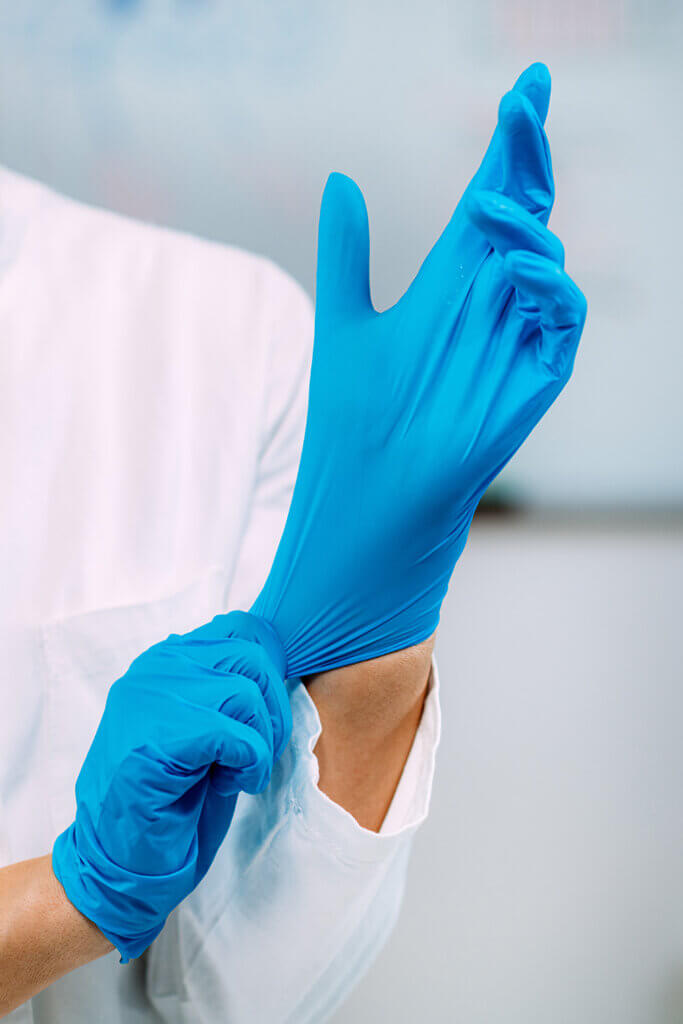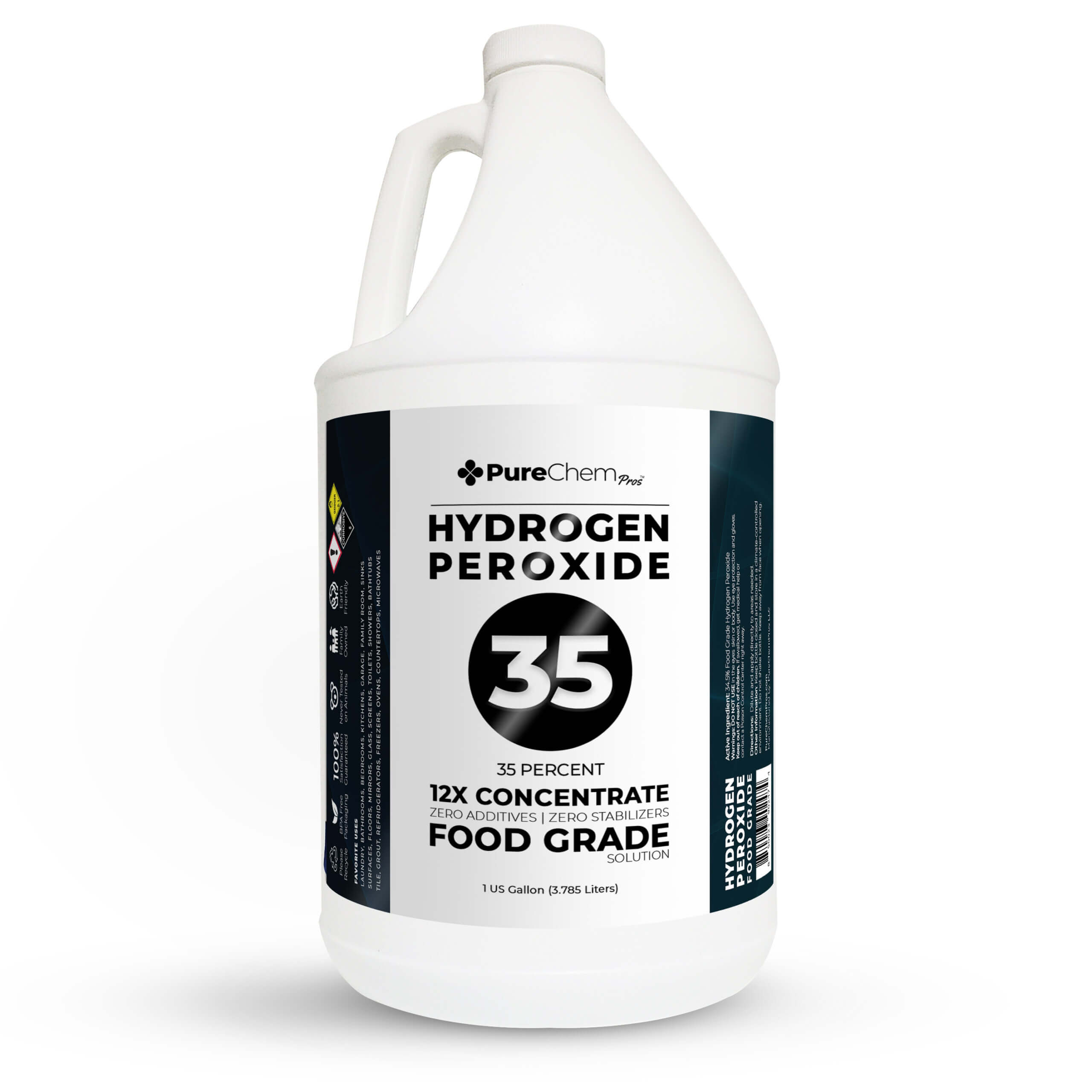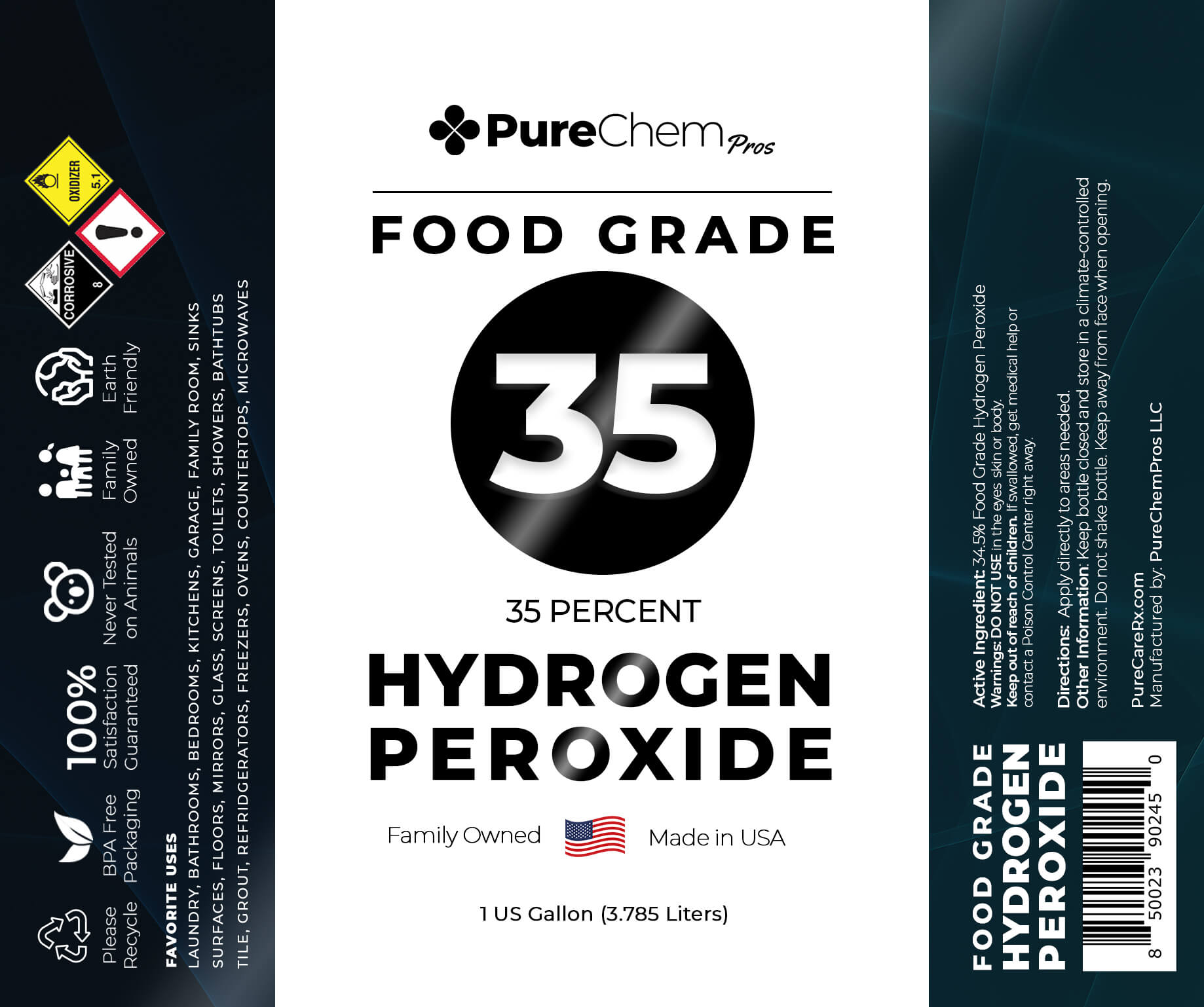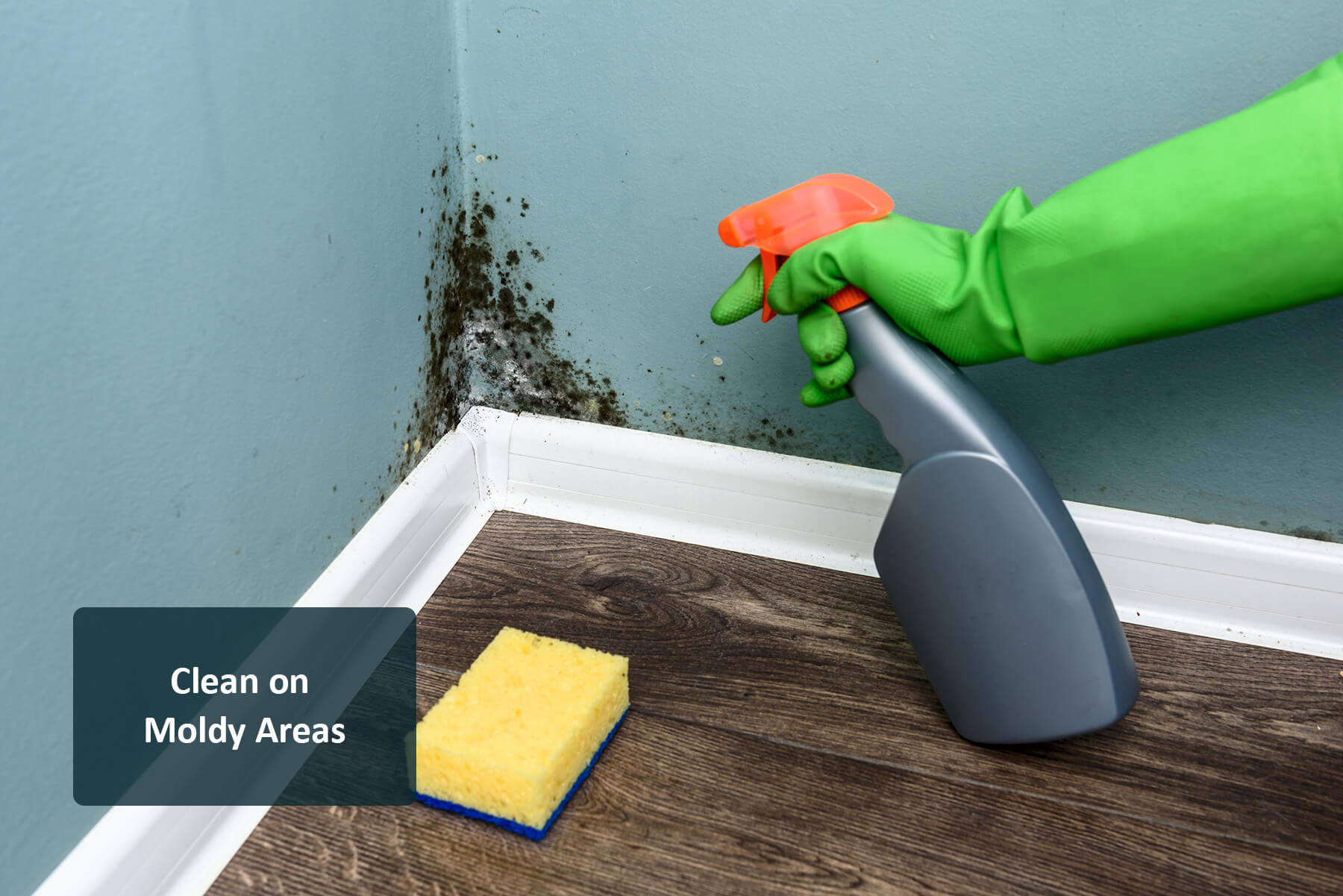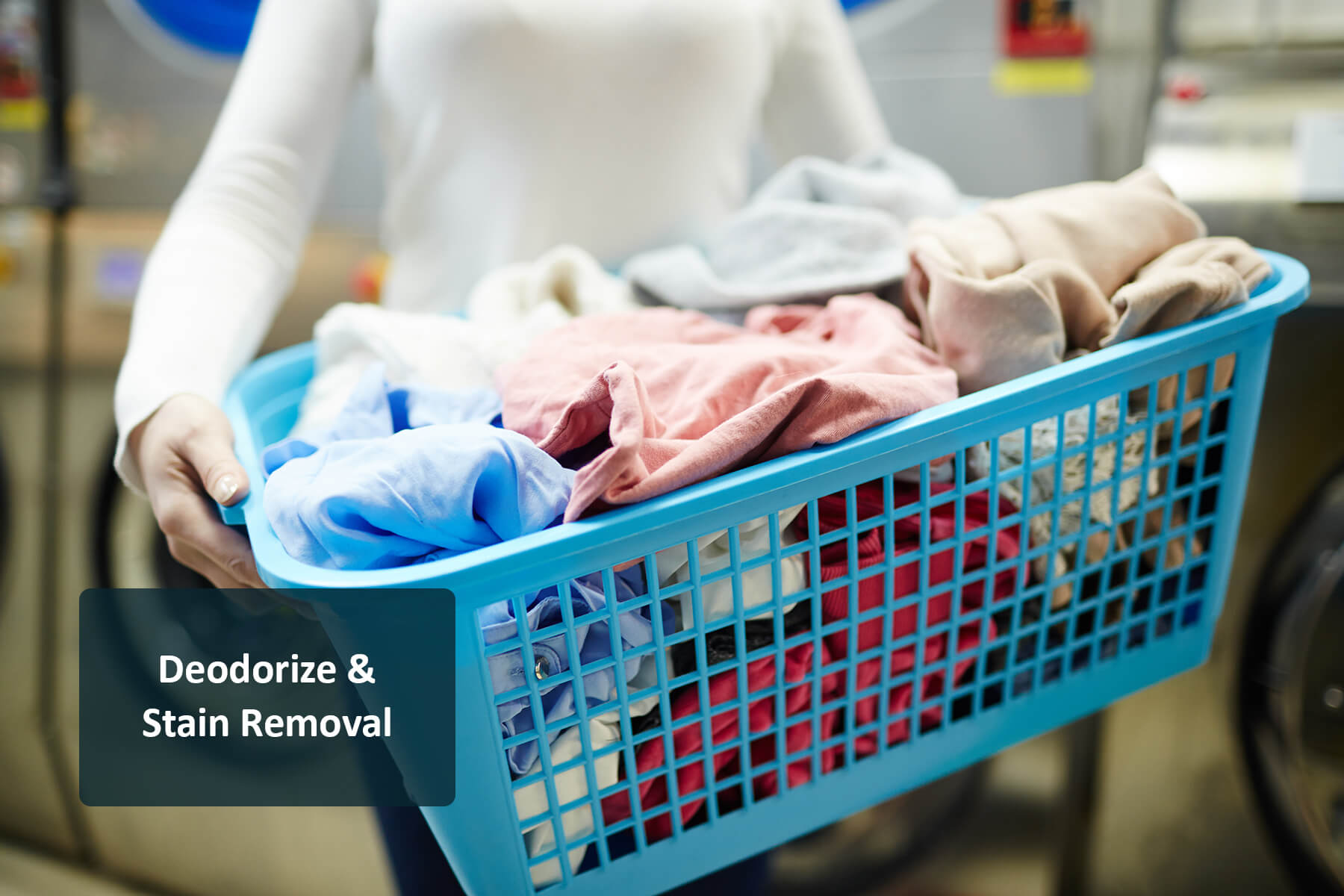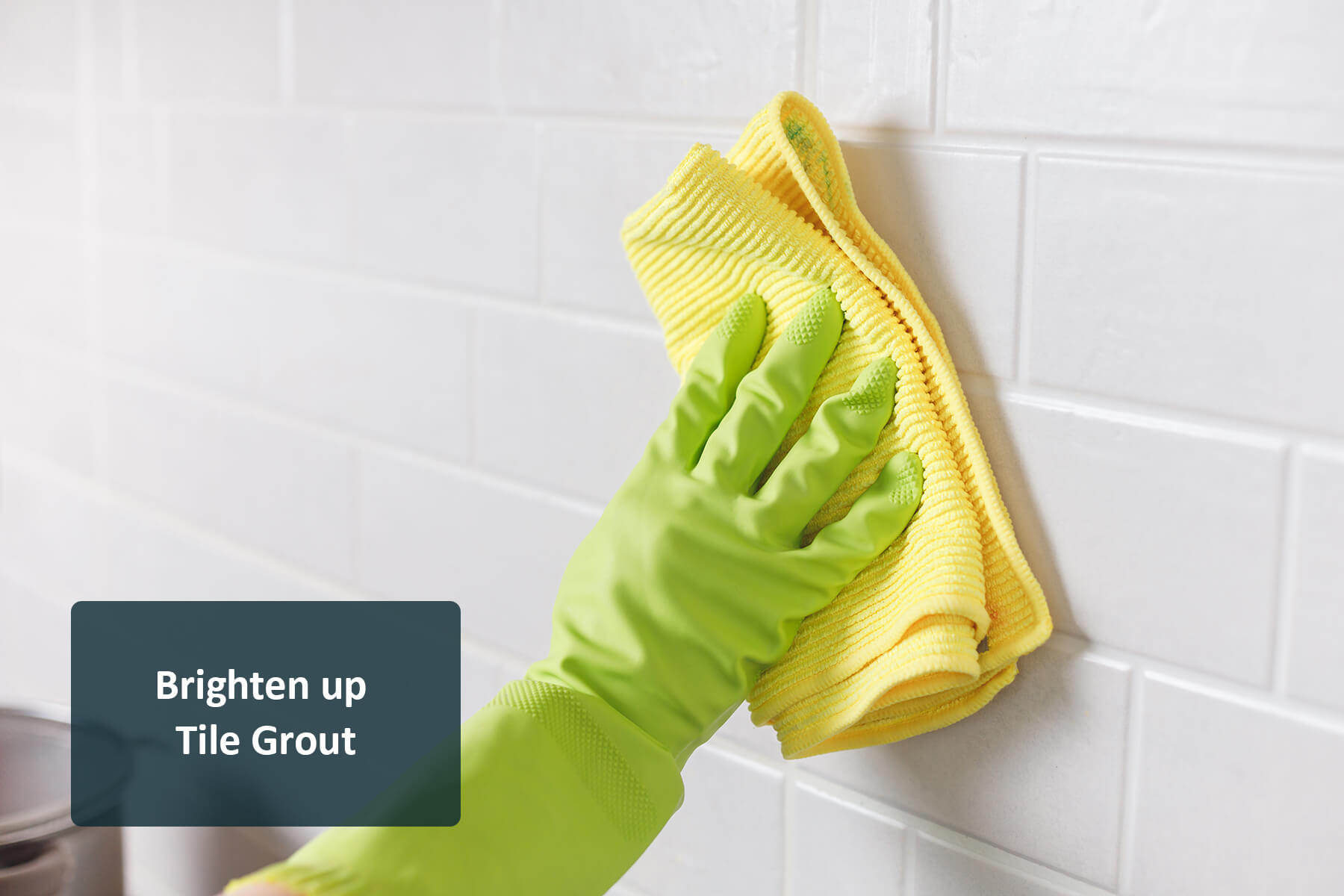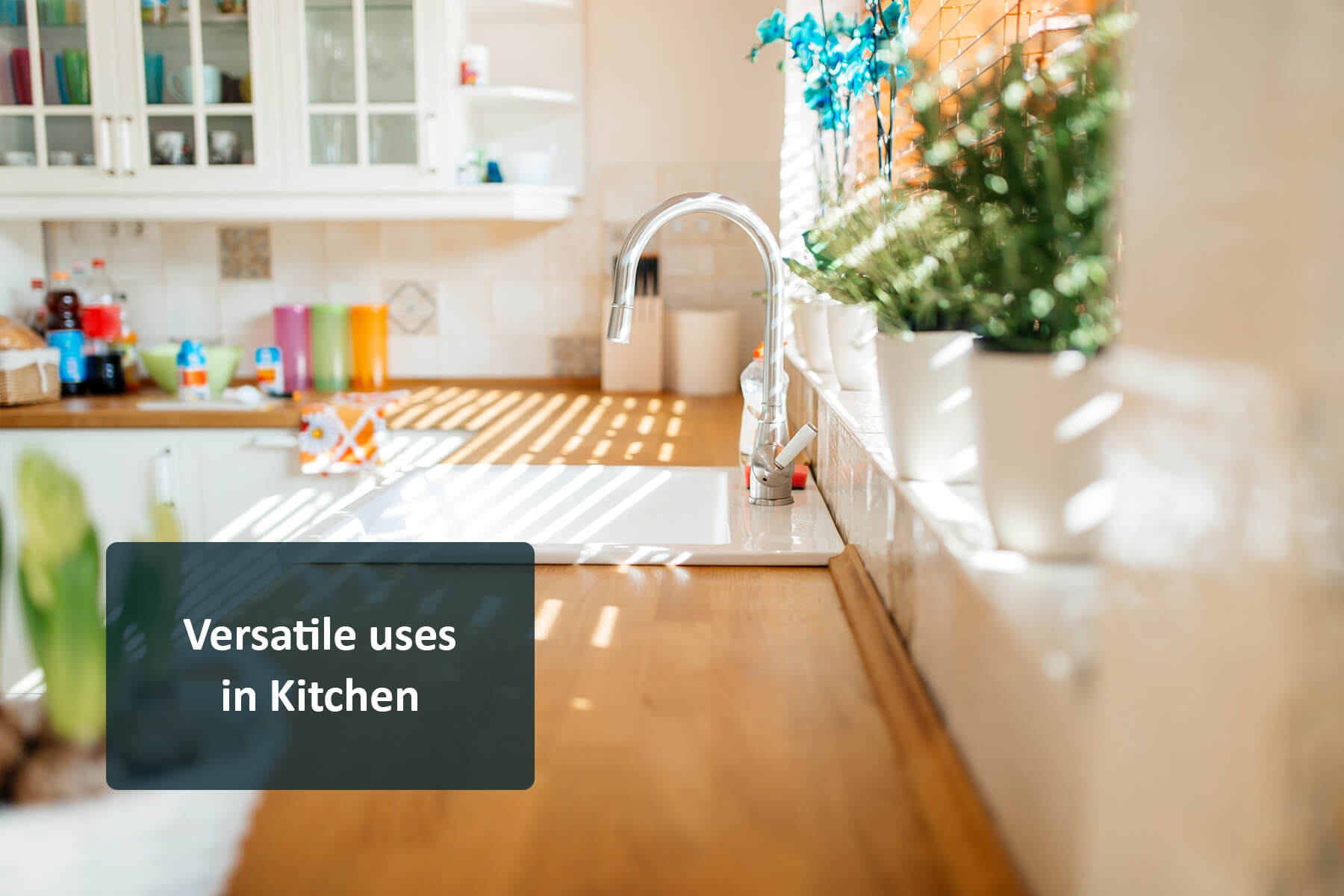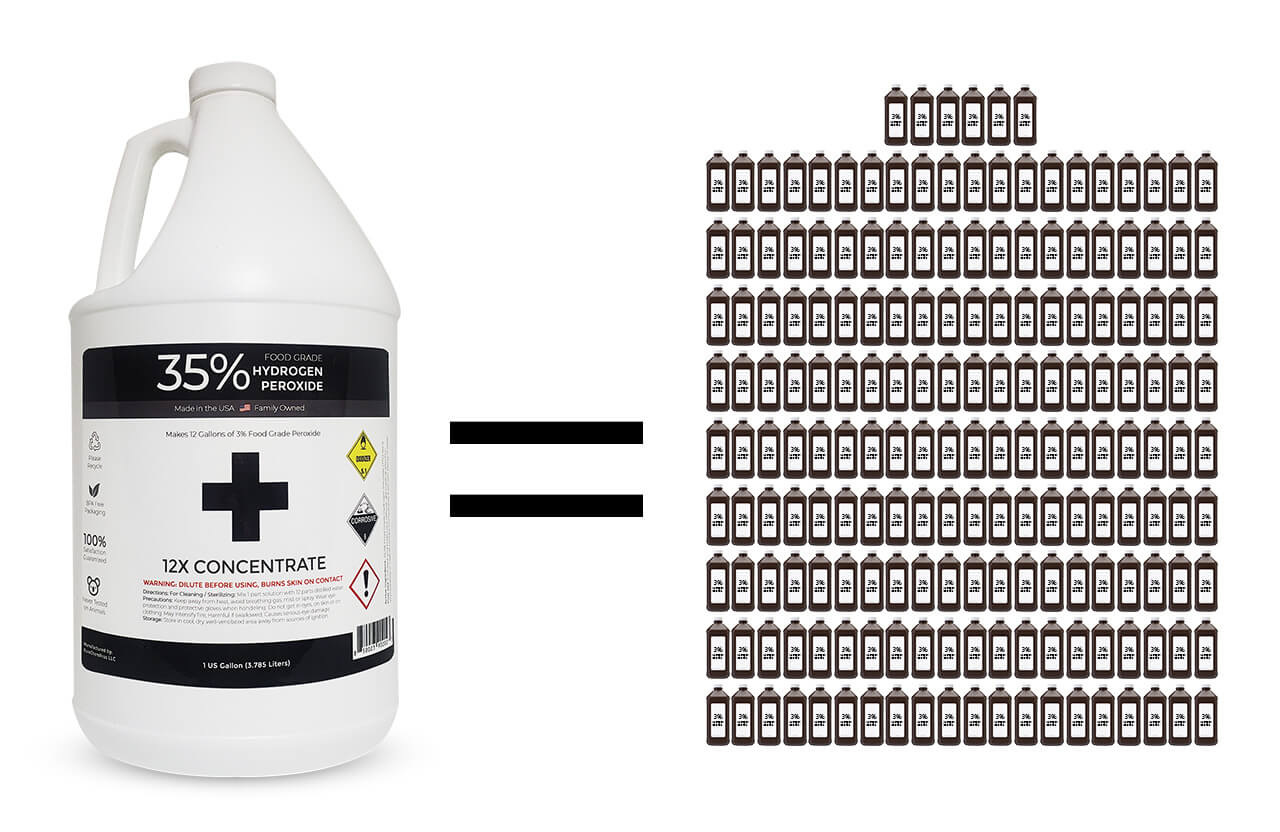35% Food Grade Hydrogen Peroxide Solution 1 Gallon
$74.99 Original price was: $74.99.$64.99Current price is: $64.99.
- No-Risk Money Back Guarantee!
- AES-256 Encryption
- SSL Secure Payments
| Product Feature | Details |
|---|---|
| Product Name | 35% Food Grade Hydrogen Peroxide |
| Weight | 9.42 lbs/Gallon | 1.1786 Ounces/Fluid Ounce |
| Color | Clear |
| Packaging Material | HDPE (High Density Polyethylene) |
| Manufacturer | PureChemPros |
| Country of Origin | United States |
| Warranty | 90 Days |
Hydrogen Peroxide Dilution Table for Making a 32oz Bottle
| Final Concentration (%) | Volume of 35% H2O2 (fl oz) | Water to Add (fl oz) |
|---|---|---|
| 20% | 18.29 | 13.71 |
| 12% | 10.97 | 21.03 |
| 6% | 5.49 | 26.51 |
| 3% | 2.74 | 29.26 |
| 1.5% | 1.37 | 30.63 |
Example: To make a 32oz bottle of 3% solution from a 35% solution, add 2.75 fluid ounces of 35% peroxide to 29.26 fluid ounces of distilled water.
Hydrogen Peroxide Dilution Table for Making 1 Gallon
| Final Concentration (%) | Volume of 35% H2O2 (fl oz) | Water to Add (fl oz) |
|---|---|---|
| 20% | 73.14 | 54.86 |
| 12% | 43.89 | 84.11 |
| 6% | 21.94 | 106.06 |
| 3% | 10.97 | 117.03 |
| 1.5% | 5.49 | 122.51 |
Example: To make one gallon of a 3% solution from a 35% solution, add 10.97 fluid ounces of 35% peroxide to 117.03 fluid ounces of distilled water.
| Property | Details for 35% Hydrogen Peroxide (H₂O₂) |
|---|---|
| Chemical Formula | H₂O₂ |
| Molar Mass | 34.0147 g/mol |
| Density / Specific Gravity | Approx. 1.13 g/cm³ at 20°C (for 35% solution) |
| Melting Point | -0.43 °C (for pure H₂O₂) |
| Boiling Point | 150.2 °C (Decomposes, for pure H₂O₂) |
| Solubility in Water | Completely miscible |
| pH | Typically around 4.5 for a 35% solution |
| Viscosity | Similar to water, slightly higher due to concentration |
| Appearance | Colorless liquid |
| Stability | Decomposes over time, especially when exposed to UV rays and heat. Stabilizers often added in commercial preparations. |
| Specific Heat Capacity | Similar to water, but slightly lower due to concentration |
| Thermal Conductivity | Comparable to water, but exact value varies with concentration |
| Vapor Pressure | Lower than water due to higher boiling point |
| Refractive Index | Slightly higher than water, exact value varies with concentration |
| Safety Concerns | Corrosive to skin and eyes, can cause burns. Decomposes to oxygen and water, which can cause pressure buildup in closed systems. |
| Storage Requirements | Store in a cool, dark place in a non-reactive container. Avoid contamination with organic materials or metals. |
Certificate of Analysis
Product Name: Hydrogen Peroxide 35%- Food Grade
Lot Number: 231002
Manufacturing Date: 2024
Expiration Date: 2025
| Item | Unit | Spec | Result | Test Method |
|---|---|---|---|---|
| Appearance | Color | Transparent Liquid | Transparent Liquid | |
| Phosphate | Below standard Chromaticity | Below standard Chromaticity | OI-6074-108 | |
| Assay | % | 30.0~50.0 | 35.55 | |
| Stability | % | Min 98.0 | 99.68 | OI-6074-101 |
| Evaporation Residue | mg/50g | Max 3.0 | 1.30 | OI-6074-102 |
| Free Acid | Red Reaction | Red Reaction | OI-6074-104 | |
| Heavy Metal (as As) | ppm | Max 4 | 0.01 | OI-6074-105 |
| Heavy Metal (as Pb) | ppm | Max 4 | 0.01 | OI-6074-201 |
| Sn | ppm | Max 10 | 0.01 | OI-6074-201 |
| Fe | ppm | Max 0.5 | 0.03 | OI-6074-201 |
* This product was tested in accordance with the corresponding test methods and results at the time of testing are reflected above.
A Company and Products You Can Trust
- Lab Certified - Our food grade hydrogen peroxide is lab certified, ensuring it meets the highest quality and purity standards set by industry-leading regulatory bodies. Rigorous laboratory testing and verification processes guarantee its safety and efficacy for various food and beverage applications.
- BPA Free - Our BPA-free bottles are manufactured using materials that do not contain bisphenol-A, a harmful chemical found in certain plastics. By opting for these safer and more eco-friendly containers, you are choosing a responsible option for storing your chemicals and other consumables.
- Cruelty Free - Our cruelty-free products are ethically produced, ensuring that no animals were harmed or tested on during any stage of the creation process. By choosing our cruelty-free options, you actively support the compassionate treatment of animals and the promotion of cruelty-free practices in the industry.
- Eco-Friendly - Food grade hydrogen peroxide is an eco-friendly alternative to traditional cleaning agents, as it breaks down into water and oxygen, leaving no harmful residues or byproducts. Its versatile and effective cleaning properties contribute to a healthier environment and reduced chemical pollution.
- Non-Toxic - Hydrogen peroxide, when used responsibly and in appropriate concentrations, is not considered an EPA hazard due to its environmentally friendly decomposition into water and oxygen. This non-toxic breakdown ensures that it doesn't contribute to pollution or harm the ecosystem.
- Family Owned - Our family-owned business takes pride in maintaining a personal touch and strong values, ensuring that every product we offer is created with the utmost care and attention to detail. By choosing our family-owned company, you support a tradition of quality, integrity, and community-driven success.
1 Gallon of 35% Hydrogen Peroxide Equals 186 Bottles of 3% Solution
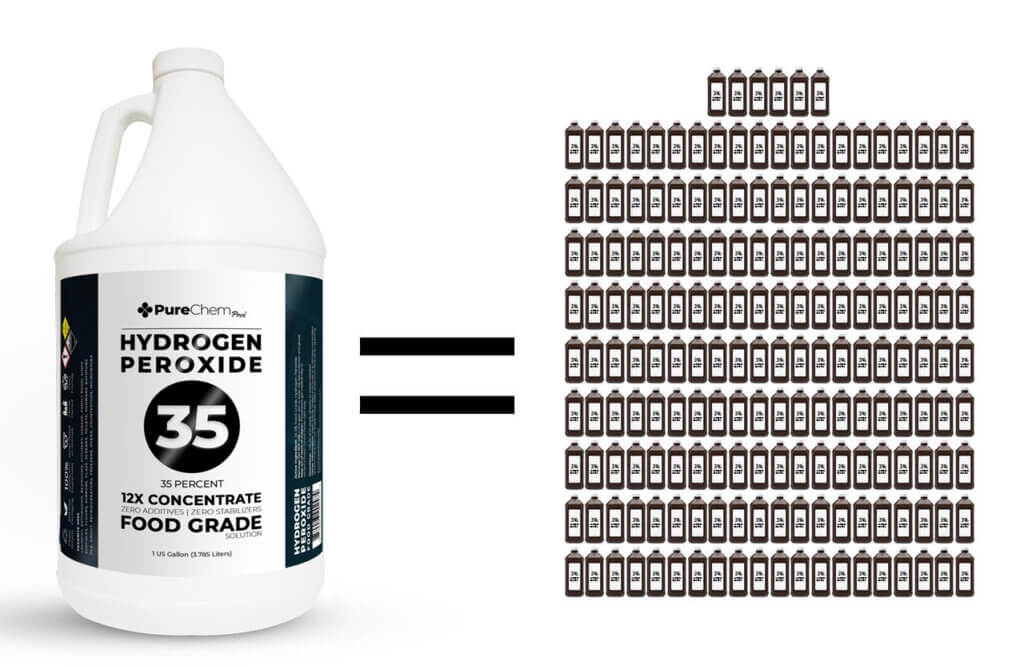
Reveal the astonishing potency and efficiency of our 35% food grade hydrogen peroxide solution, offering incomparable value and earth-friendly features. One gallon of this dynamic concentration can displace a startling 186 typical 8-ounce bottles of 3% peroxide, shrinking waste and storage necessities. This flexible solution is ideal for multiple applications, such as cleaning, sanitizing, and even horticulture. By selecting our concentrated hydrogen peroxide, you not only cut back on costs but also foster a greener lifestyle by curbing plastic waste and alleviating the environmental burden of manufacturing and shipping. Experience the merits of our 35% hydrogen peroxide solution and join forces with us in promoting a positive change for the planet and your wallet.
Reviews and Experiences Shared by Our Clients
Cleans Well
Great product that cleans well as a diluted veggie soak or on countertops, floors, and everything in between! I want to try a diluted wash on my rugs.
Over all very pleased!
This seems to be a hiigh quality food grade peroxide. I received my order pretty quickly. It was broken down in to 32 oz bottles to avoid Hazmat charges, but I was still charged at the same pricing as gallons (slightly more $/oz than 32 oz bottles). I received them all in the same box, and packaged within the same bag. Thank goodness it was leakproof because a solid 2 oz had leaked out of one of the bottles. With the cost of high quality FG H2O2, I hated losing that 2 oz. Outside of those 2 small issues, I’m pleased with the product so far!
Great stuff
I used this product before on many items and I am back for more. I use it to clean & disinfect so many things. Thank you for this wonderful product.
Careless delivery
One of the bottles was open with half of the content missing!
Damaged Open Products
The Product itself is great. But six 32oz bottles were leaking when I got them. Left multiple voicemails to the business and no responses. Left chemical burns on my hands from opening the package and coming in contact with the leaking peroxide. I would at the very least expect a refund for the leaking product.

Awful Company and Service!
I will NEVER use this company again. My first order got damaged by FedEx, not the companies fault but it took 4-5 to hear from anyone about it. I called, emailed and texted. Finally someone responded but it took multiple days to come up with a solution because the lack of communication was so awful. Then they resent a new order and it was only half of what I originally ordered. Again it took DAYS for anyone to respond. They did finally refund me but I will NEVER do business with them again. The lack of communication and apathy from them was just awful.
Incomplete order
I bought 4 gallons and only received 2
poor service
i placed a order of 4 gal. and was offered a additional 4 gal.with discounted price which i accepted i have not yet received after trying to call and sending email . i have only received 1 email which told me my order was shipped in 2 shipment and one may have been damaged and they would check on it . i have asked for a refund and have not heard a thing .i do like the product but the service sucks i will be looking for other places to make my purchase . i know iam only one customer but customer service goes a long way
Minor packaging issues
Upon receiving the package, the was peroxide that had leaked onto the other bottles. While trying to clean them off, I received several burns. Please make sure your products aren't leaking before shipping. Product seems quality and I'll likely order from them again.
Fast
very Happy with my experience.
Great product
It's a great product at a great price !! Bulk peroxide made it a quick and easy transaction. And fast shipping !!
Very Satisfied
Ordered 2 gallons plus other stuff. They delivered 7 qts instead of 8. One quick call and the 8th quart was on its way that very day. A pleasure to work with them. Thank you for your great customer service
35% h2o2ever
everything was great
Clean water
Super! It does a great job in our hot tub.
Works wonders
This is the real deal. I am so happy I found this website, I’ll be purchasing more. Thank you!
Great product
Works like magic !
Food grade stuff
Good stuff for cleaning
Very helpful and rewarding
Quick and Easy!!
The purchase was quick and easy!
Awesome product
Excellent for cleaning bath tub and tile around the tub. Delivered on time.
35% hydrogen peroxide
The product was exactly as advertised.
This is a great value
I bought 4 - 32 oz bottles and saved the hazmat fee.
Very good service
Great will be ording more
Great product! Great service!
This was my second time purchasing this product, and I think it is fantastic. I particularly like the option to purchase a gallon in 32 ounce containers. Keep up the good work.
Great
Awesome! Thank you very much!
Best Food Grade H2O2 Provider!
This is my second purchase of a gallon of FGHP. I will not shop anywhere else! Good quality, great prices and fast delivery!
Toxic free cleaning.
Good as always.
Very Pleased!
Very pleased with the cleaning experience I get while using this product!
Great Product
Quality and service are good.
Great for my pool
Great for keeping my pool clean and hygienic. Currently this is all I am using.
How to Dilute 35% Food Grade Hydrogen Peroxide to a 3% Solution in a 32oz Bottle Using Deionized Distilled Water
Items required:
- 35% food grade hydrogen peroxide
- Deionized distilled water
- A clean, empty 32oz bottle for the final 3% hydrogen peroxide solution
- Measuring cup or graduated cylinder
- Funnel
- Safety goggles
- Rubber gloves
- Apron or old clothes

Step-by-Step Guide:
- Safety first: Before you begin, ensure you are wearing safety goggles, rubber gloves, and an apron or old clothes to protect yourself from any accidental spills or splashes.
- Prepare the workspace: Choose a well-ventilated area with a flat surface to work on. Make sure the area is free from flammable materials, heat sources, and direct sunlight.
- Calculate the required dilution: To dilute 35% food grade hydrogen peroxide to a 3% solution in a 32oz bottle, you’ll need to determine the necessary amount of deionized distilled water to add. To do this, use the following equation:(Initial Concentration × Desired Volume) / Final Concentration = Volume of Concentrate Needed In this case: (3% × 32oz) / 35% ≈ 2.79oz (volume of 35% hydrogen peroxide needed)Subtract the volume of concentrate needed (2.79oz) from the desired volume (32oz) to find the required amount of deionized distilled water: 32oz – 2.79oz ≈ 29.21oz
- Measure the 35% hydrogen peroxide: Using a measuring cup or graduated cylinder, carefully measure 2.79oz of 35% food grade hydrogen peroxide.
- Measure the deionized distilled water: Using a measuring cup or graduated cylinder, carefully measure 29.21oz of deionized distilled water.
- Mix the hydrogen peroxide and deionized distilled water: Using a funnel, slowly and carefully pour the 2.79oz of 35% food grade hydrogen peroxide into the empty 32oz bottle. Next, using the same funnel, add the measured 29.21oz of deionized distilled water to the bottle, leaving a little space at the top for the solution to mix properly.
- Seal and shake the bottle: Once the hydrogen peroxide and deionized distilled water have been combined, securely cap the 32oz bottle. Gently shake the bottle to ensure thorough mixing of the solution.
- Label the bottle: Clearly label the bottle as “3% Food Grade Hydrogen Peroxide” to avoid confusion in the future.
- Store the diluted hydrogen peroxide: Store the 32oz bottle of 3% food grade hydrogen peroxide in a cool, dark place, away from direct sunlight and heat sources.
Remember always to exercise caution when handling concentrated chemicals, and keep your diluted hydrogen peroxide out of reach of children and pets.
Guide to Properly Storing 35% Hydrogen Peroxide
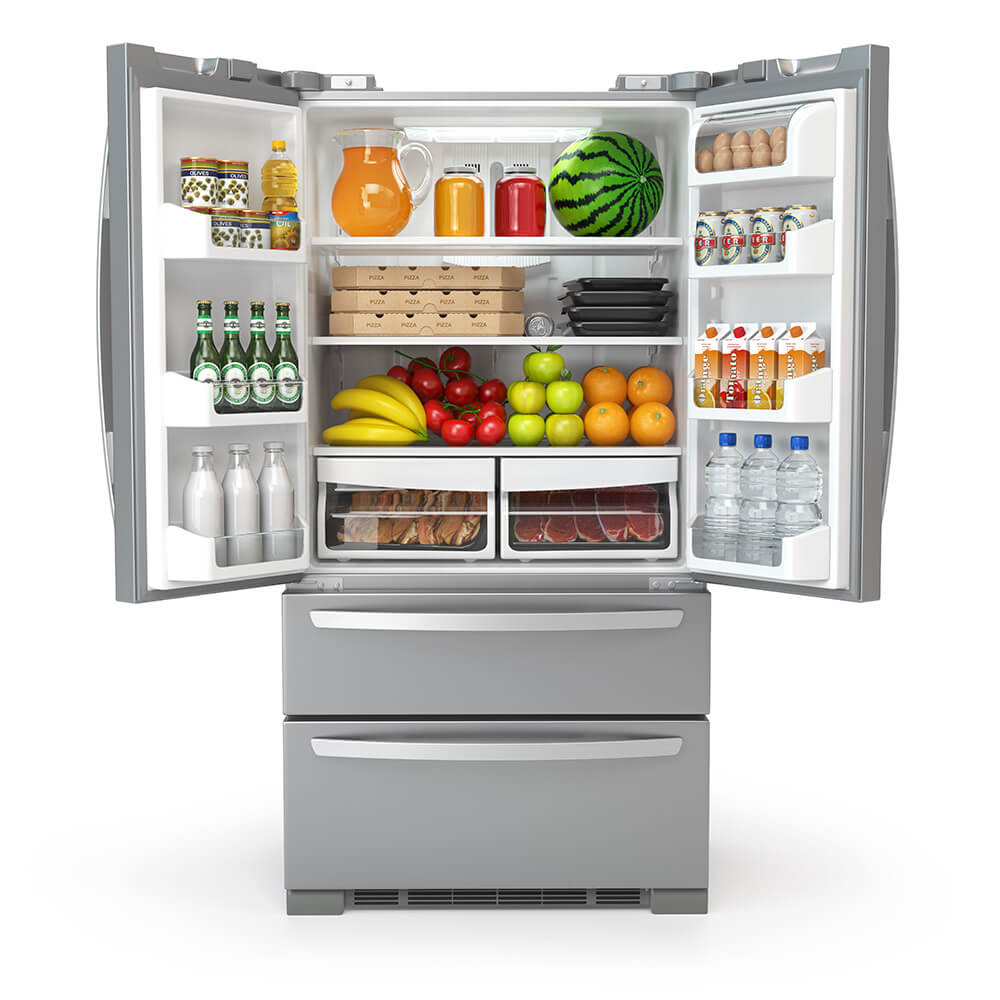
- Use an appropriate storage container: Store 35% hydrogen peroxide in a dark, opaque container made from non-reactive materials like HDPE or glass to shield it from light and maintain its potency.
- Apply clear labeling: Mark the container with the contents, concentration, and necessary safety warnings to ensure correct identification and prevent accidents.
- Store in a suitable environment: Keep the container in a cool, dark place, away from direct sunlight and heat sources for optimal stability and safety.
- Keep away from flammable items: Due to its strong oxidizing capabilities, store hydrogen peroxide separately from flammable materials to reduce the risk of combustion.
- Position the container correctly: Always store the hydrogen peroxide container in an upright position to avoid leaks and spills.
- Inspect the container frequently: Regularly examine the container for any signs of damage, leaks, or cracks, and safely transfer the hydrogen peroxide to a new container if necessary.
Discovering the Various Uses of 35% Hydrogen Peroxide
- Maintaining Cleanliness of Surfaces and Kitchen Utensils: Hydrogen peroxide effectively neutralizes microscopic elements on diverse surfaces, helping to establish a clean and safe space.
- Addressing Mold and Mildew: The solution’s strong oxidizing qualities assist in the breakdown and removal of mold and mildew in moisture-prone locations.
- Encouraging Plant Vitality: In a diluted form, hydrogen peroxide can support root health and elevate oxygen availability in the soil.
- Lifting Stains from Textiles: Hydrogen peroxide serves as a mild bleaching agent that can remove challenging stains while preserving fabric quality.
- Cleansing Fresh Produce: Hydrogen peroxide is useful for eliminating grime, pesticide residues, and microscopic elements from fruits and vegetables.
- Dealing with Soap Residue: Hydrogen peroxide is effective at breaking down and eliminating soap buildup on bathroom surfaces like tiles, shower curtains, and glass doors.
- Purifying Water: Hydrogen peroxide is capable of making water safer by neutralizing potentially harmful microscopic elements.
- Managing Algae in Water Features: Hydrogen peroxide helps regulate algae by decomposing organic material and enhancing oxygen levels in water.
35% Food Grade Hydrogen Peroxide: Solutions to Your Frequently Asked Questions
What are the primary uses of 35% Food Grade Hydrogen Peroxide?
How should I store 35% Hydrogen Peroxide safely?
Can 35% Food Grade Hydrogen Peroxide be used for mold removal?
How do I neutralize 35% Food Grade Peroxide spills?
Can 35% Food Grade Hydrogen Peroxide be used successfully to maintain clean and hygienic kitchen areas?
Is Food Grade 35% Hydrogen Peroxide safe for use in hydroponic systems?
Can 35% Hydrogen Peroxide be used to clean fish tanks and aquariums?
How does 35 Percent Food Grade Hydrogen Peroxide differ from pharmacy-grade hydrogen peroxide?
Is 35% Food Grade Peroxide suitable for cleaning vegetables and fruits?
What precautions should be taken when handling 35% Peroxide?
Is Food Grade 35% Hydrogen Peroxide eco-friendly?
Is 35% hydrogen peroxide suitable for purifying water?
Can 35 Percent Food Grade Hydrogen Peroxide be used as a laundry booster?
How long does 35% Food Grade Peroxide maintain its potency when stored?
What is the difference between 35% Peroxide and 12% Food Grade Hydrogen Peroxide?
Is 35 Percent Food Grade Hydrogen Peroxide safe for cleaning baby toys and accessories?
35% Hydrogen Peroxide: Safety Measures and Tips
